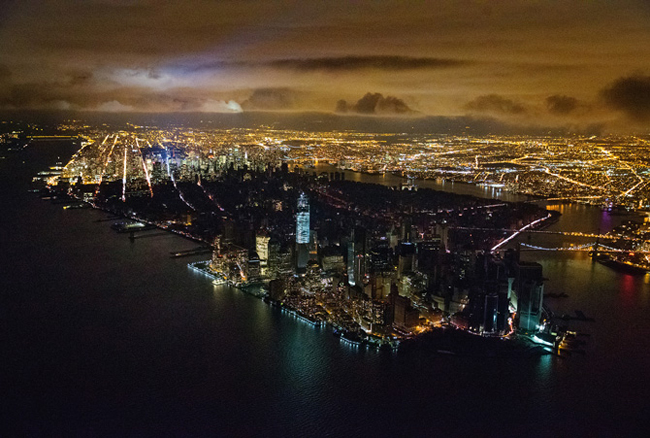
In Manhattan, Superstorm Sandy's surging tide in late-October 2012 knocked out a Con Ed substation, darkening the city below Manhattan. Private generators provided some light, including the blue glow of the new World Trade Center, whose base is three feet above sea level. Photograph by Iwan Baan, Reportage by Getty Images, Reprinted as part of National Geographic's "Rising Seas" coverage.
– Article by Paul C. Focazio, New York Sea Grant
Washington, D.C., November 22, 2014 - Late last month marked the two-year anniversary of Superstorm Sandy’s landfall in the Metro NY region. Since then, there have been many positions taken by researchers and decision-makers alike on which management response route New York should take: one of resistance (one of precaution and prevention), resilience (bringing back our communities back to their pre-storm state) or re-alignment (evolve and reconfigure what, how and when to rebuild).
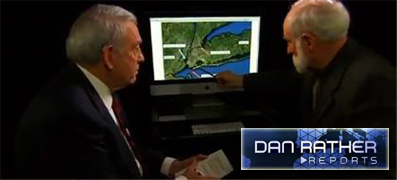 "I cannot tell you when the next big one will be," said Stony Brook University (SBU) School of Marine and Atmospheric Sciences (SoMAS) oceanography professor and storm surge expert Dr. Malcolm Bowman (pictured above, at right, with Dan Rather, at left) on Dan Rather Reports just a few months out from Sandy. "But it will come. It's inevitable in the long term. And the sooner we come to that realization, the better. Because the longer you put it off, the more damage and destruction and heartache we're going to face."
"I cannot tell you when the next big one will be," said Stony Brook University (SBU) School of Marine and Atmospheric Sciences (SoMAS) oceanography professor and storm surge expert Dr. Malcolm Bowman (pictured above, at right, with Dan Rather, at left) on Dan Rather Reports just a few months out from Sandy. "But it will come. It's inevitable in the long term. And the sooner we come to that realization, the better. Because the longer you put it off, the more damage and destruction and heartache we're going to face."
For over a decade, New York Sea Grant has funded studies of Bowman's as well as other investigators in the Stony Brook Storm Surge Research Group, for which he is the lead.
"Sandy is a wake-up call to all of us in this city and on Long Island," Bowman, told NBC News reporter Richard Engel, who surveyed the damage from a police helicopter on Thursday, November 1, 2012, just a few short days after Sandy hit the metro NY area. "That means designing and building storm surge barriers like many cities in Europe already have."
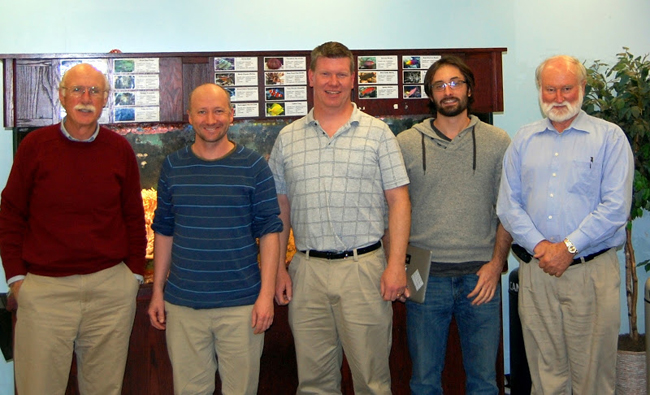
The Stony Brook Storm Surge Research Group Team Members: (l-r) Charlie Flagg, Hamish Bowman, Brian Colle, Keith Roberts, Malcolm Bowman. Absent: Jian Kuang and Alexandra Santiago. Photo courtesy of Malcolm Bowman. In their most recent NYSG-funded, two-year project (which wrapped up earlier this year), the Group worked on a more accurate storm surge model prediction system that could easily be adopted by the National Oceanic and Atmospheric Administration (NOAA) National Weather Service as well as regional emergency managers for regular and accurate predictions over the Northeast seaboard with a focus on Metropolitan New York and Long Island.
Back in 2005, NYSG’s Research Coordinator Lane Smith conducted the first feature-length interview with Bowman for the program’s newsletter, New York Coastlines. The article, entitled “Closing the Door on Storm Surges,” included images with simulated flooding scenarios for several locales in lower Manhattan, many of which are only a few feet above sea level and are therefore at high risk for water inundation should a huge storm surge accompany a severe storm such as a hurricanes or nor’easter. Add to that the impact of global warming and sea level rise, which would increase the frequency and severity of damaging storms, and Bowman says, “The damage done by a 100-year storm now will equal the damage done by a 25- or 50-year storm later in the century if sea level rise accelerates.”
Five years later, NYSG’s Communications Manager Barbara A. Branca continued the conversation with Bowman’s SBU SoMAS and Stony Brook Storm Surge research colleague Brian Colle, among others, for another NY Coastlines feature, “The Quiet Before the Storm?” The basis of the discussion was a research paper Colle co-authored that had been published in the Journal of Applied Meteorology and Climatology.
In the work, Colle and his fellow researchers sought to give forecasters and emergency managers a refined conceptual model of what local and regional atmospheric conditions are likely to cause flooding in the New York City area. Says Colle, “New York City will be increasingly more vulnerable to storm surge as sea level continues to rise, thus suggesting the need to take more immediate action to protect the city from more frequent larger flooding events.
Cut to late October 2014, some nine years later, when Colle looks back at Superstorm Sandy and says, “All storm surge models failed leading up to the storm, which we are only just beginning to understand.”
And while Colle sees great value in improving how we communicate severe storm data and warnings, he adds, “The number of people on projects working toward improving the storm surge models and predictions is not optimal, primarily because the funding has transitioned to supporting more projects on the outreach of hazard information – and how to be resilient – and less on the science of the hazard itself.”
“As a researcher, Sandy was very difficult for me,” says Colle. “For years, my colleagues and I were urging that a big storm like this could come, it was just a matter of time. Among other things, we translated the science by writing papers and taking part in stories for Sea Grant newsletters, but struggled to be heard at the local, state and NYC levels.”
“Even today decisions are being made about resilience without merging the latest science with the policy and decision makers. So, on a communication level, we have a huge gap right now between science and policy, partly because the time scales are different (next election cycle vs. the next storm in 10-20+ years).” In order to bridge some of those gaps, Colle says SBU SoMAS and the U.S. National Weather Service hosted a late-November workshop at Stony Brook University. At the forum, he and other experts discussed some of the latest approaches, issues, and potential solutions between communication and the decision process as they relate to extreme weather events. Also, there was an unveiling of "Reality Deck," billed as "the next generation visualization system to immerse both the forecaster and decision maker."
“To me it is really a process or series of steps to prepare for severe weather events,” says Colle. “It’s not one thing, and of course we need to be reminded each year – not only how to prepare, but also what is latest state of the science of the risk so we can prepare better.”
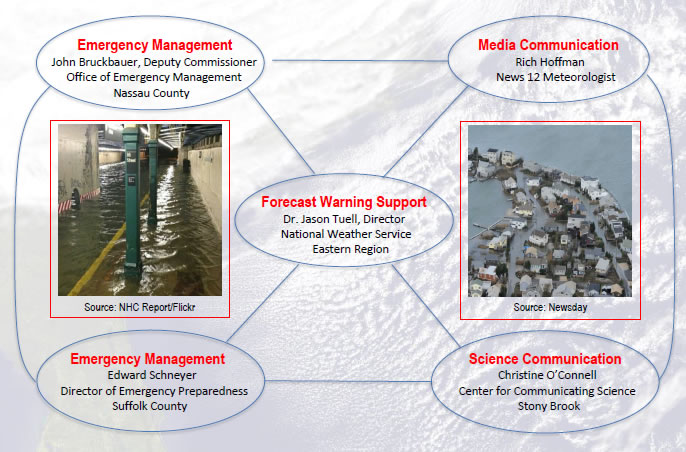
Another way to strengthen communication is within communities themselves, which is the basis for a $1.4M multi-year effort funded by the National Oceanic and Atmospheric Administration (NOAA), the National Sea Grant College Program’s federal parent agency. A series of 10 projects are currently underway in this, the Coastal Storm Awareness Program (CSAP), which is a partnership between NOAA and Sea Grant programs in New Jersey, New York and Connecticut. For more, see www.nyseagrant.org/csap.
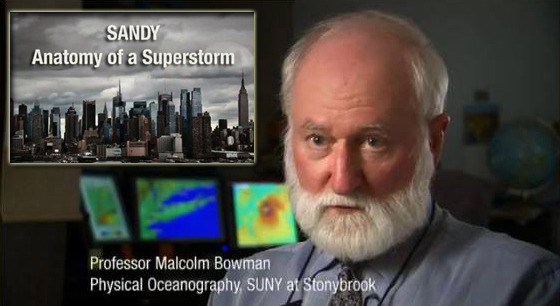
On Monday, October 29, 2012, Superstorm Sandy made landfall in the Metro NY region. A month later, BBC premiered an hour-long documentary on the "Anatomy of a Superstorm," for which Bowman and others provided insights on Sandy and where we should go moving forward when it comes to being prepared for severe storms."The time has come for a series of storm surge barriers to protect New York, northern New Jersey, and parts of western Long Island Sound from this ever happening again," said Bowman. While the barriers would take decades to build and cost at least $10 billion, Sandy has already tallied over $62 billion in economic losses, making it the second most costly storm event in U.S. history. Bowman urges, "This is a serious proposal that the City now should investigate." Six months later, in May 2013, Bowman followed up with the BBC for a four-and-a-half-minute radio interview.
Below are some additional thoughts on the topic of communicating “the science behind Superstorm Sandy” – where we’ve been and where we should be headed two years later – as seen through the eyes of SBU Stony Brook Storm Surge lead investigator Malcolm Bowman:
1. Having recently passed the second anniversary that Superstorm Sandy impacted the U.S. East Coast and, in particular, the tri-state area, what do you think are some of the lessons learned?
How complicated the interleaved levels of government are, the lack of regional cooperation and planning (particularly at the inter-state level) and the American system of land use planning being handled at the local (town) level … How difficult it is to get elected officials to plan for far-distant events … How to change the culture of reacting to catastrophic events rather than being proactive to ensure that such catastrophes never happen again.
(a) With the news cycle shifting to other stories over time, do you think there are things we need to be reminded of so that we are better prepared for future severe storms?
That we must be prepared to spend huge amounts of money to ensure the safety of people and infrastructure against future extreme events. There is no quick fix; particularly with Long Island’s south shore consisting of low-lying sand dunes and filled wetlands with over-development in many vulnerable areas. Also Metro New York needs a regional solution, which includes northern New Jersey. New York City neglects this seemingly-obvious fact.
(b) What is the one thing everyone needs to know about preparing for a hurricane?
That each hurricane has its own trajectory, its own characteristics, its own signature and yes, its own surprises.
(c) Last fall, NOAA and three of its Sea Grant programs – New York, New Jersey and Connecticut – began a $1.4M multi-year, 10 project effort to improve community awareness and response to coastal storms. This involves not only how people receive severe storm information, but also how that scientific data is translated into what is then reported by the media.
How do you see the role of communications in the process of communities becoming more storm resilient?
The media do a good job in general. I found the coverage of Sandy and its aftermath generally excellent. My professional engineering (PE) and environmental conservation qualifications and interests have also been useful in helping to bridge the philosophical divide between “grey and green”. People and groups from both ends of the spectrum are often talking past each other instead of to each other.
However, for example, many people in the very vulnerable coastal public housing sectors do not obtain their information from traditional sources such as the print media, so that TV is their main source of news, and that is useless once the power goes off.
Training young volunteers to act as news and warning couriers is one idea I have promoted, such as working with the youngsters of the Rockaway Waterfront Alliance. There is still much suffering by displaced and dispossessed persons and families and this hurt and hardship now falls below the news radar. There are many touching human interest stories yet to be published.
The Rebuilding by Design competition sponsored by HUD and underwritten by the Rockefeller Foundation produced a plethora of highly imaginative solutions to making the coastline more resilient; alas many of them are unrealistic due to a lack of understanding of the physics and characteristics of storm surges.
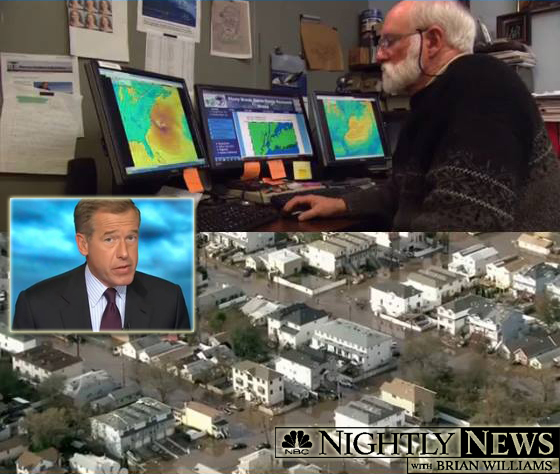
Within days of Sandy’s impact in Fall 2012, Bowman (top photo) was talking about combating severe storms with NBC’s Brian Williams (inset picture) as well as newscasters and reporters for CNN, ABC National Public Radio, PBS, among others.
What are some of the successes and struggles that you think scientists like yourself face in strengthening those ties with the public, the media and decision makers?
Getting through to the decision makers is the biggest challenge. The power to control what the appropriate responses are, and should be, lie in the hands of a very few individuals who put their stamp on what should happen. Getting through to the media is relatively easy. Getting through to the public via professional societies is what I do often, but it is very time consuming.
(d) What do you think about the discussions that local, state and national officials have been involved in (such as NY RISE) and plans (like PlaNYC) that they have created – are helping to further the conversation?
It certainly helps but they need to be made into permanent organizations that can conduct world-class scientific research that feeds into intelligent decision making and sound policies.
(e) What does the research that you, Brian Colle and the other Stony Brook Storm Surge Group investigators show you in terms of what else we could or should be doing to make us more storm resilient?
Understanding better the science of regional meteorology and oceanography of the eastern seaboard has made us more aware of the vulnerabilities of the region and that future catastrophes could easily happen again within our lifetimes.
My own views are well known; that building resilience is of course necessary, but the piecemeal approach is insufficient to protect us against future catastrophes. What is needed is a regional solution; including the participation of New Jersey. For Metro NY this means European style multi-purpose storm surge barriers, protecting both NY City and the industrial/transportation networks of NE NJ. For Long Island it means continuous replenishment of south shore beaches, but also smaller barriers at the various inlets to prevent flooding via the back bays, such as happened to the City of Long Beach.
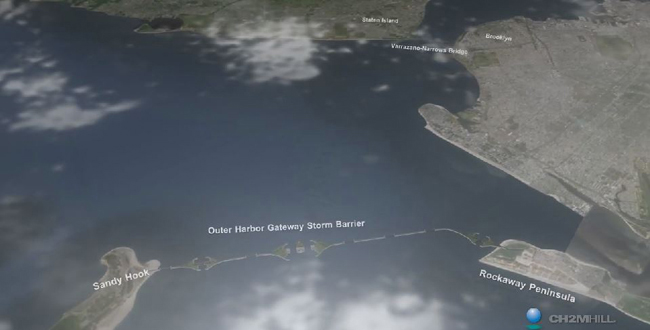
Still image from 3D animation showing a design concept for the NYC Outer Harbor Gateway Storm Barrier. This animation was used in PBS NOVA's "Megastorm Aftermath," which aired in October 2013. Courtesy of CH2MHILL 3D Visualization Studio.
2. How long has your research been funded by Sea Grant? What have your coastal hazard studies shown you over time that has been most impactful for decision-makers and the general public to know about?
We’re going on 12 years now. How hard it is to develop regional plans for long term protection. No one is talking about how long we can continue to live at the edge of the sea. My own time horizon for NYC and LI is 150 years. Then we will have to retreat from substantial areas of the coast as we get overwhelmed.
3. What drove you to work in the field of coastal hazards? What is something cool you learned while working in this field?
I was working on storm surge science well before Sandy struck and quickly became aware of the vulnerabilities of the region. Coastal meteorology and oceanography are fascinating branches of science.
4. What is the biggest challenge you face at your job?
Keeping the research funding going and training graduate students to the high levels of expertise necessary to run our various prediction models. Ensuring that the public, science advisers and policy makers realize that we are in a new climate era and the problems are not going to go away, but will continue to get more severe over the coming decades.
5. When did you know you wanted to pursue a career in science?
When I was 12 years old.
6. What part of your job did you least expect to be doing?
What I am doing now. My original interests lay in electronics and radio science (I have a BS in physics and mathematics, an MS in radio physics, and a PhD in engineering physics).
7. What’s at the top of your recommended reading list for someone wanting to explore a career in science?
A Short History of Nearly Everything, by Bill Bryson (2003).
8. And how about a personal favorite book?
A History of the World in 100 Objects, by Neil MacGregor (2011).
9. Do you have an outside hobby?
Photography.
10. What has surprised you most about working with Sea Grant specialists and administrators?
I’ve worked with Sea Grant staff on and off for over 40 years; it has been a great pleasure to witness some of my former students rise to positions of authority in the organization, so nothing surprises me.
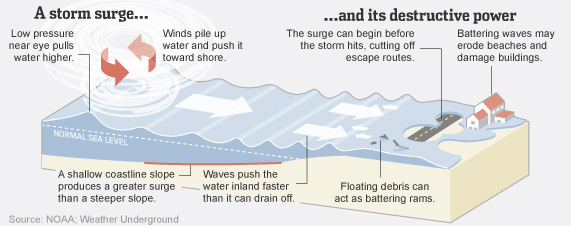
A storm surge is the rise of water driven toward shore by storm winds, over and above predicted tide levels, according to the National Oceanic and Atmospheric Administration. Storm-surge flooding varies widely, depending on the height of terrain along local coastlines.
A Timeline: A Sampling of Sea Grant’s “Superstorm Sandy” Stories
(More in our archives atwww.nyseagrant.org/hurricane and www.nyseagrant.org/superstormsandy)
More Info: NOAA
NOAA's mission is to understand and predict changes in the Earth's
environment, from the depths of the ocean to the surface of the sun, and
to conserve and manage our coastal and marine resources. Join NOAA on Twitter, Facebook and our other social media channels and visit the organization's news release archive.
More Info: New York Sea Grant
New York Sea Grant (NYSG), a cooperative program of Cornell University
and the State University of New York, is one of 33 university-based
programs under the National Sea Grant College Program (NSGCP) of the
National Oceanic and Atmospheric Administration (NOAA). The NSGCP
engages this network of the nation’s top universities in conducting
scientific research, education, training and extension projects designed
to foster science-based decisions about the use and conservation of our
aquatic resources. Through its statewide network of integrated
services, NYSG has been promoting coastal vitality, environmental
sustainability, and citizen awareness about the State’s marine and Great
Lakes resources since 1971.
For updates on Sea Grant activities: www.nyseagrant.org has RSS, Facebook, Twitter, and YouTube links. NYSG also offers a free e-list sign up via www.nyseagrant.org/coastlines for NY Coastlines, its flagship publication, which, in 2014, merges with the program's e-newsletter, Currents. NY Coastlines is published several times a year.More Info: NOAA
NOAA's mission is to understand and predict changes in the Earth's
environment, from the depths of the ocean to the surface of the sun, and
to conserve and manage our coastal and marine resources. Join NOAA on Twitter, Facebook and our other social media channels and visit the organization's news release archive.